Nokia Lumia 930 Review
by Brett Howse on September 8, 2014 3:00 PM EST- Posted in
- Smartphones
- Microsoft
- Nokia
- Mobile
- windows phone
- Lumia
Battery Life
For the battery life tests, we have a standard workload that the phone performs while connected over Wi-Fi, or Cellular data. The display is calibrated at 200 nits for consistent comparison data for the charts. The device is run under this standard load until it shuts down.
Windows Phone has a battery saver mode, so these tests were done twice. Once with battery saver disabled, and another with it enabled which stops all background events from being run.
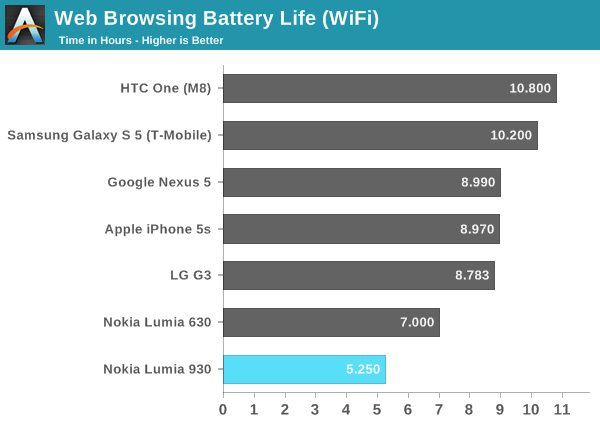
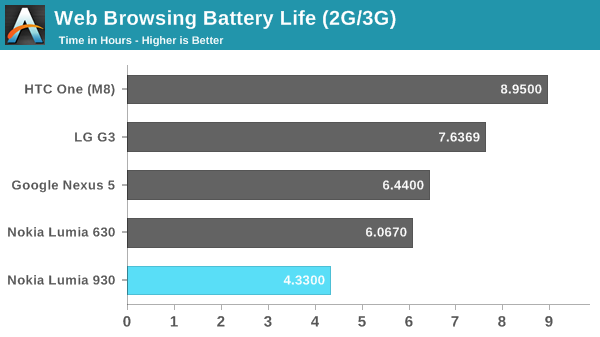
The Lumia 930 has an integrated 2420 mAh 3.8 V battery, for a total of 9.2 Wh. This is quite a bit smaller than the battery in the Galaxy S5, which has the same screen size and also has a removable battery. Unfortunately the Lumia 930 is one of the worst performers in battery life in a long time, with just over five hours of Wi-Fi battery life. The phone gets very warm during these tests. The AMOLED display in this phone seems to draw an exorbitant amount of power when displaying the mostly white content of our web browsing tests. I was unable to test over LTE due to the model of 930 that was shipped to me for review not supporting any of the LTE bands in my area, but over HSPA the result is unsurprisingly even worse than Wi-Fi, with only 4:20 of runtime.
Windows Phone also includes a Battery Saver feature, which disables most background tasks from being able to function unless you have specifically allowed them. Email, as an example, must be manually synchronized rather than having push support. With the Lumia 630 this dramatically increased the runtime of the phone.

As we saw with the Lumia 630, Battery Saver has a significant impact on battery life. However, we simply go from terrible to bad. The Lumia 630, with a smaller battery, does significantly better with its low resolution LCD display in this test.
Another battery test we can perform is by using BaseMark OS II, which contains a battery life test. This eliminates us depending on the javascript engine as part of our test.
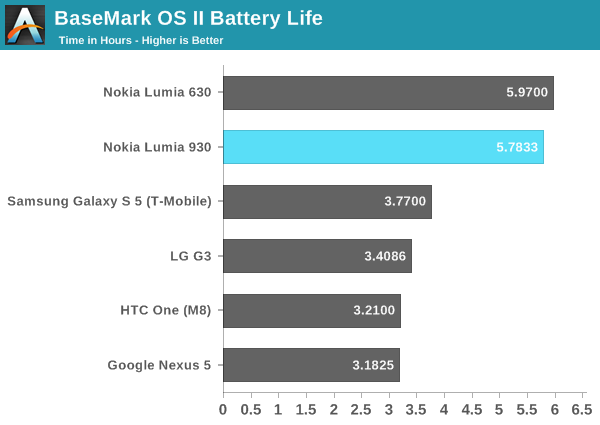
The Lumia 930 almost completely flips the table here.In fact, the native benchmark even surpasses the Wi-Fi web browsing test.
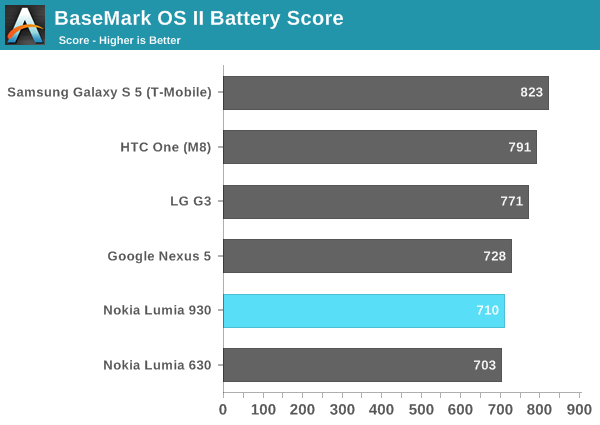
On the battery score for the Basemark test, the Lumia 930 does not do as well as the high runtime would suggest, falling behind other devices once again, but in this test, it is much closer than the web browsing test.
Charging
The Lumia 930, with the latest version of Windows Phone, supports Qualcomm’s Quick Charge 2.0 specification which allows a higher voltage charger to be used for much faster charging. The 930 also supports built in Qi wireless charging.
The 930 which was sent for this review came with an EU wall plug, which is obviously incompatible with North American electrical outlets. The charger shipped with the unit supports up to 1.5 A at 5 V, but the highest amperage charger available to me was a 1 A version which I used for these tests. Expect better results if using the 1.5 A version, or especially if you have a Quick Charge 2.0 capable charger.
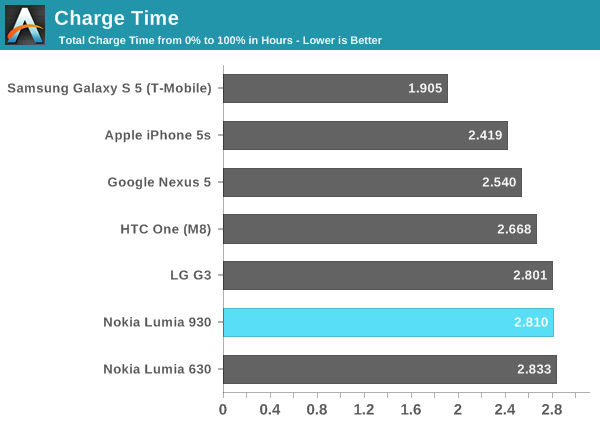
At almost three hours, this is a bit high, but with the correct charger this should be closer to the 2.5 hour mark, if not under.
Battery Conclusion
With a smaller battery than other devices of a similar size, it is not surprising that the Lumia 930 can not keep up with the competition, but it was surprising just how poorly it fares in the web browsing tests. The phone would get noticably warm during the web browsing test.
As Anand found during his review of the Samsung Galaxy Tab S, AMOLED devices can suffer in the web browsing tests due to the mostly white backgrounds, but they can excel at video, and the Lumia 930 follows in the same direction, but white backgrounds put a major strain on the battery of this device. Still, the newer generation AMOLED in the Galaxy S5 could last 10 hours with its 10.78 Wh battery.
The Lumia 930 is not a small phone. In fact, with the straight sides, the Lumia 930 has quite a bit of volume to it. One of the tradeoffs of sealed battery phones like the Lumia 930 is that you should be able to fit more battery into the device because you don't have to worry about the shape of the battery, or have a plastic case around the battery for an end user to handle. The Lumia 930 does not follow with this logic. It is difficult to comprehend how a phone this size can not have a larger battery in it.
That being said, real world battery life was never a big issue for me during my time with the phone. The battery saver app will give you an estimate as to how much time is remaining before the device needs to be charged, and it always showed well over a day. Many of the Windows Phone hubs and apps have black backgrounds, which can dramatically increase the battery life of AMOLED devices which also contributes. Still, with the progress on battery life in the last several generations of phones, one would expect more.










115 Comments
View All Comments
Arbie - Monday, September 8, 2014 - link
SD police here...So my low-end Nokia 520 has microSD, which lets me easily swap in TV series that I watch when traveling or to kill time waiting somewhere. A new 930 at much higher price won't let me do that.
Hmmm... my love affair with Nokia (the 520 is great) will be coming to an end.
Windows Phone doesn't even have the flimsy excuses of the Android camp for no SD. It can even be read-only dumb storage, with no security issues. But no.
Not interested / will never buy it.
tuxRoller - Monday, September 8, 2014 - link
The Android issues aren't with security but, from what a Dev claimed (falsely, IMO) poor user experience.NikAwesome - Tuesday, September 9, 2014 - link
SD, mSD or whatever external storage are at least an order of magnitude slower than eMMC or ONFI or more advanced NAND interfaces. When an application like the Photo Gallery browser has to read lots of pictures from SD it is really a torture (several seconds, or tens of seconds). In the first eras of tablets and smartphones, people get accustomed that all has to launch in less than second (give or take), faster than their desktop application launch at home/work. So in this context, several seconds is inappropiately interpreted as sluggish CPU performance when the real bottleneck is in the storage IOs. These delays severely impact usability if you are used to full internal flash storage, where everything opens in under a second.I am not against mSD cards, I have an 8GB S4 mini and 32 GB mSD. I can easily tell the performance difference, but I have no choice if I want to take lots of pictures or film lost of 1080p videos.
Summing up, performance is the real reason why Google do not allow external storage on their devices (Nexus smartphones and tablets). From Apple point of view is arguable that they had contracts with music label records inheriting the iPod policy: "easy to load music into the device, a pain in the ass to extract it in order to make piracy more difficult"
jimbo2779 - Tuesday, September 9, 2014 - link
If you think sd cards make viewing photos on a phone a chore them it could be your phone or its support of SD cards that is at fault on the Lumia 620 there is no noticeable difference between photos on the phone memory and in SD card.Also there seems to be very little difference, if any, between the 620with all pics on SD and a925 with no SD support so speed is not a reason.
tobi1449 - Tuesday, September 9, 2014 - link
Plus: What's worse, photos that take a little bit longer to load or photos that either don't load at all because you don't have them with you or take much much longer and half of your free data?marcokatz - Friday, September 26, 2014 - link
Well Nokia sure is trying, but Microsoft is not exactly helping them out (they even released their own app for iPhone first... gosh). Anyway, as of today it's much better to go for one of the really good Android phones. /Marco from http://www.consumertop.com/best-phone-guide/tuxRoller - Tuesday, September 9, 2014 - link
That wasn't the reason given, iirc. The problem he mentioned was one of user removes sdcard, doesn't see his photos/apps on phone and gets confused. The other issue was technical, but, again iirc, was fixable if they wanted.jimbo2779 - Tuesday, September 9, 2014 - link
While that is the one technical issue with SD card implementation I would say there is a very small amount of people that would be able / willing to switch out the SD card and not be aware that they would be missing the contents of that SD card when they go into their photos app.When you remove a DVD from your computer do you wonder why you can't watch your favourite film anymore? Would anyone?
I am sure it has happened to someone at some point but realistically how many people would that affect compared to the amount of people that would put an extra 32 or 64 Gb in their phone and just be happy to have doubled or tripled their storage to keep a years worth of photos and videos of their kids on their phone.
Either way you look at it having the option to massively extend the amount of internal storage to have more media / apps in your phone is more favourable to most compared to having to resort to the cloud (which is just a no-go for a good portion of smartphone users across the world) or constantly removing stuff to make the newest stuff fit.
I would miss Glance but without SD card I will not be buying this which is a shame I was looking forward to it, don't even get me started on how the rumours for the 830 got me all excited and left me disappointed when the phone was finally announced. Either the 830 or 930 could have been WP halo phones for a lot of potential detractors to the WP platform, instead they are just a few tweaks short of stacking up very favourably with their android competition.
tuxRoller - Tuesday, September 9, 2014 - link
The technical issue was actually brought up by the poster below me (pjcamp). It was regarding creating a unified storage space across multiple devices.To be clear, I am NOT saying these were good reasons, I only brought them up in response to the parent who I thought MIGHT have been claiming that the reasons android dropped sd card support was related to security.
I really wish that sdcards (or some other removable storage standard) made a comeback on android.
Rama TT - Saturday, September 13, 2014 - link
"""Summing up, performance is the real reason why Google do not allow external storage on their devices "" Yeah right and it has nothing to do with Google Drive